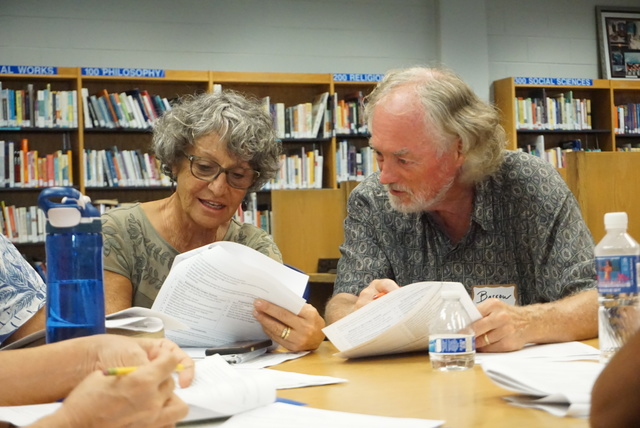KEALAKEHE — More than 40 teachers, administrators and others came out Wednesday evening for a town hall meeting about the Every Student Succeeds Act and the future of public education in Hawaii.
The meeting was the first of two scheduled on the Big Island that give the public an opportunity to weigh in on a “blueprint” as the state works to implement a new federal schooling law. The next one is scheduled for Aug. 24 at Waiakea High School at 4:30 p.m.
The Every Student Succeeds Act, signed into law in December 2015, replaces the No Child Left Behind Act. The new law is intended to give states more flexibility in developing standards for their schools.
“This is huge,” ESSA team chairperson Darrel Galera told the crowd at Kealakehe High School. “The opportunities that have been presented in this law are unprecedented.”
The blueprint is distinct from the Department of Education’s strategic plan review and the ESSA plan being submitted to the federal government.
While all three are being developed simultaneously, each has its own purpose.
The blueprint, Galera said, is a framework intended to determine the specific needs of the community and gather opinions on what education should look like. The strategic plan, on the other hand, focuses on how the Department of Education can meet those needs and its goals.
The plan being submitted to the federal government is an outline of what Hawaii will do to meet the requirements of the new law.
Before those plans are set in stone, however, Galera said the state is soliciting feedback from those who know Hawaii schools best.
“It’s not like we already have what it is,” he said. “We are taking voices from across the state in developing this blueprint.”
First-year teacher Dantavious Hicks, a seventh-grade math teacher at Kealakehe Intermediate School, said he’s eager to learn the direction the district is heading.
Hicks, who recently moved to the Big Island to teach, said that while he doesn’t have much experience with public education here, he feels the state is making an effort to make room for change here.
“I feel like there’s an effort to accept feedback,” he said.
West Hawaii Complex Area Superintendent Art Souza said that effort to seek feedback at a grassroots level makes a difference.
“They’re legitimately seeking authentic community voices,” he said.
That, he said, is “the only way you’re really gonna get innovation and change.”
Souza said he also appreciates the focus on empowerment, saying administrative empowerment doesn’t just mean the authority to make decisions, but also the flexibility to “go out and have others make decisions with me.”
“That kind of synchronistic thinking can lead to some good things,” he said.
Barrow Hutchison, a special education teacher at Kona Pacific Public Charter School, said the blueprint plan doesn’t relate to him as a charter school teacher.
Hutchison said he attended the presentation out of “pure curiosity to learn more” but that he was skeptical of its ultimate impact.
Still, he said it was a good presentation and was glad he attended.
He added that changes pursued through the plan will only impact him as a teacher “if we begin to respect the profession and encourage imaginative thinkers.”
The state can support that by giving teachers the “freedom to work in the classroom and training to observe the student.”
On the issue of Hawaiian content in schools, an area where the ESSA team asked for feedback, Hutchison said students can be encouraged to find a “sense of freedom” through a “sovereign point of view.”
“What is all this if it doesn’t build toward sovereignty?” he asked.
Hutchison said sovereign thinking involves students being able to think independently for themselves.
No matter what someone’s opinion is on the plan for Hawaii education though, it’s important to be heard when given the opportunity, said West Hawaii Complex Area administrator Marcella McClelland.
“The bottom line is there’s gonna come a plan out of this change,” she said, adding that if people “have definite opinions,” they need to take part in the process of making those opinions known.
“We all recognize the need for change and be a part of it,” she said.
McClelland said she believes the school system can play a role in boosting business on the island and creating an environment where Hawaii students want to stay or return after their schooling.
“We need to create jobs that have our kids able to come back home,” she said.
That can be done, she said, by cultivating and building on Hawaii’s talent pool, which can draw business to the island.
“We really do have the talent,” she said.






